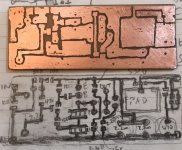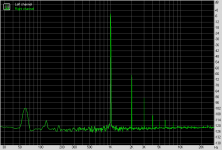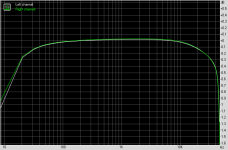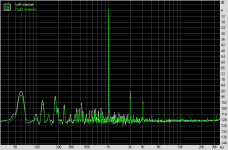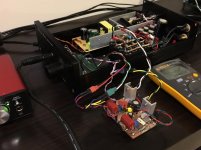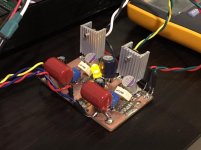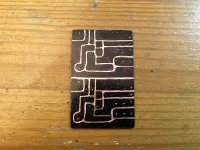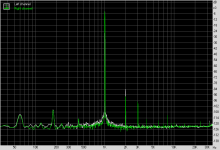One question X,
Many thanks BTW, what is the current through the jfet? I'm assuming around 10mA?
Did you assess the subjectives with source degen with 0R, 70R, and 150?
Interesting that you selected HALF the range! WOW!! Do you think it's best FIXED, or VARIABLE?
Sorry, I'm quite keen on this amp, and I'm living vicariously through your testing.......!
Cheers,
Hugh
I think we cross-posted. Current through BF862 was about 6.8mA. I forgot to add andesisorr in series son my 100R pot is the entire range at present. It was late and with one test track I could not easily detect an audible difference with one ear and a dance track from Daft Punk playing
Subjectively so far, it sounds very nice and close to MOSFET version - which is to say, exceedingly nice. I think the gain feels a tad lower as it is not quite as loud. That must be a function of BD140 Hfe? Perhaps cherry pick one with higher Hfe for more gain?
It is very quiet even when running with DC-DC converter and cap Mx. Bass extension is excellent and highs and mids are clear and transparent. No harshness or sibillance detected (I listened to 5 tracks - jazz trio, fenale vocals (2), hip hop dance, rock). Very nice amp from what I know of headamps!

What I am looking forward to is real time tweaking pot to get the perfect harmonic profile.
For reference:
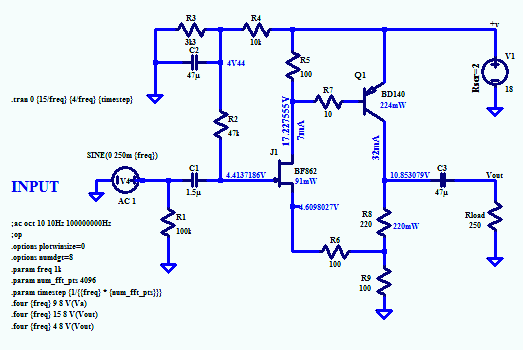
Here is my PCB layout (note I have an error on pinout of BD140 and had to cross legs 2&3 in practice. Otherwise, layout works well and has excellent amount of PCB area to dissipate heat from power resistors and cap Mx.
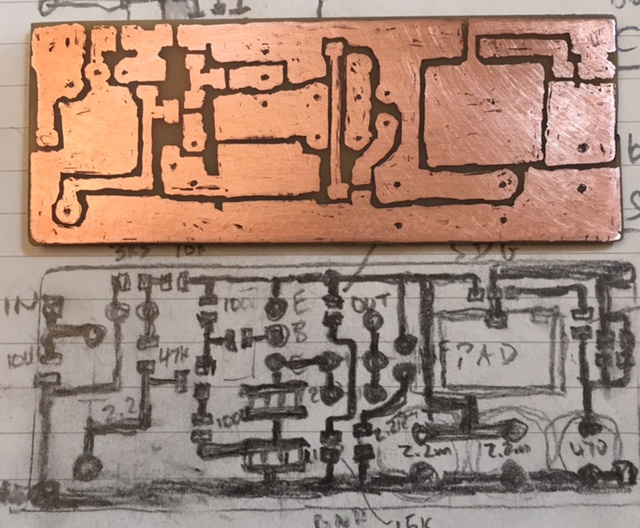
Attachments
Last edited:
Thanks X,
During development of the FetZilla, we found that a pnp VAS sounded threw up a marvellous image, which the mosfet VAS could not. We found the mosfet did not require Cdom, but the pnp did. Draw your conclusions - the mosfet has many parasitics which cost some of the phase performance. The bipolar has a lot more gm too, which leads to much less variation of the jfet Id. I'm not sure that hfe is very important, however.
Do you see a good argument for a 'niceness knob' or is this redundant once the best value is reached?
Thanks again for the hard work,
Hugh
During development of the FetZilla, we found that a pnp VAS sounded threw up a marvellous image, which the mosfet VAS could not. We found the mosfet did not require Cdom, but the pnp did. Draw your conclusions - the mosfet has many parasitics which cost some of the phase performance. The bipolar has a lot more gm too, which leads to much less variation of the jfet Id. I'm not sure that hfe is very important, however.
Do you see a good argument for a 'niceness knob' or is this redundant once the best value is reached?
Thanks again for the hard work,
Hugh
Hi Hugh,
I have to build second channel and listen in stereo to perceive any phase coherence advantages. Although given the technical reasons like higher gm of the BJT - it probably will be audible. Is there another BJT that might be even better here? KSA1381? 2SA1837? I have those available to try out too. That Toshiba 1837 might just be the Cat's Meow here? Once I can listen in stereo and play around with niceness knob at several settings then I can give assessment of whether or not ability to change makes a difference.
You don't have to thank me - I thank you for giving me such a cool design. It has to be built! It wasn't that hard as there are only 2 transistors and a handful of resistors.
I have to build second channel and listen in stereo to perceive any phase coherence advantages. Although given the technical reasons like higher gm of the BJT - it probably will be audible. Is there another BJT that might be even better here? KSA1381? 2SA1837? I have those available to try out too. That Toshiba 1837 might just be the Cat's Meow here? Once I can listen in stereo and play around with niceness knob at several settings then I can give assessment of whether or not ability to change makes a difference.
You don't have to thank me - I thank you for giving me such a cool design. It has to be built! It wasn't that hard as there are only 2 transistors and a handful of resistors.
Last edited:
Measurements of JFET-BJT Headamp with Niceness Knob
Aksa,
I know you have been waiting for this one... I hooked up the amp to the Focusrite Solo Gen2 audio interface and took some data. Initially with the SMPS and DC-DC converter. When using the DC-DC converter, too many HF artifacts showed up in the FFT so I removed it and connected a pair of fresh Li-ion 9v batteries (measure 16.0v) after the cap multiplier. The HF components were fairly low in the -100dB to -110dB range but I wanted to give this amp a fair test.
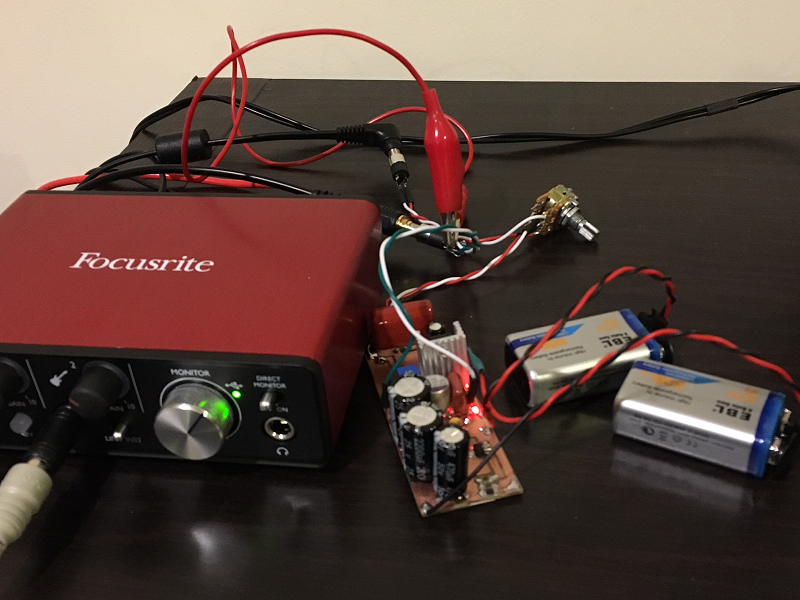
Here is a typical FFT with the DC-DC converter and 12v SMPS as power source:
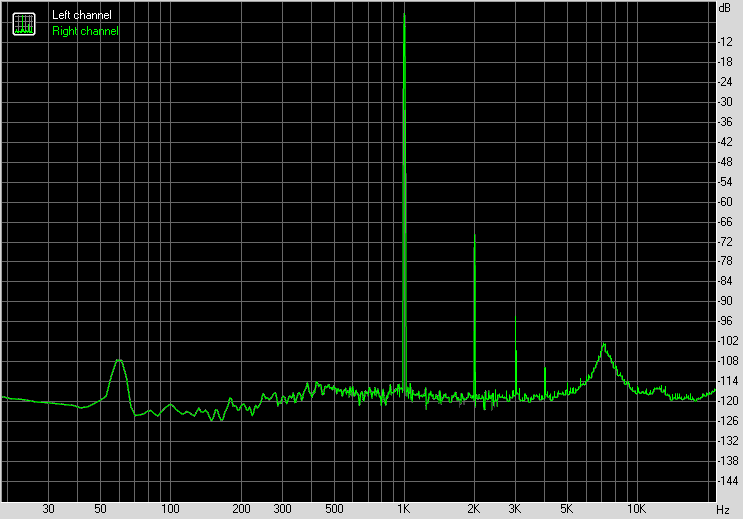
So with batteries, I took data with R6 set from 0ohms to 100ohms in 25ohm steps. The trend is that at lower degeneration resistance values, the THD is lower, and increases pretty much linearly with increasing resistance. Note that there is a 60Hz peak but that is probably EMI pickup due to fact that amp is not in a metal box as everything is battery powered. The -120dB noise floor is quite flat otherwise.
R6=0ohms:
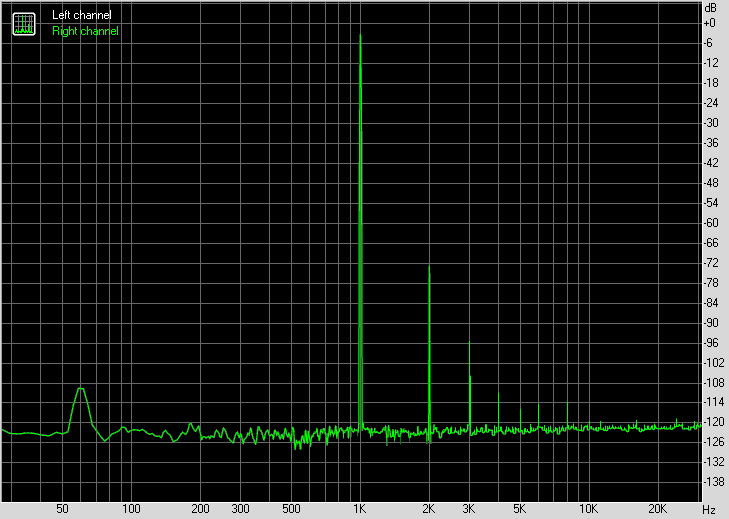
R6=25ohms:
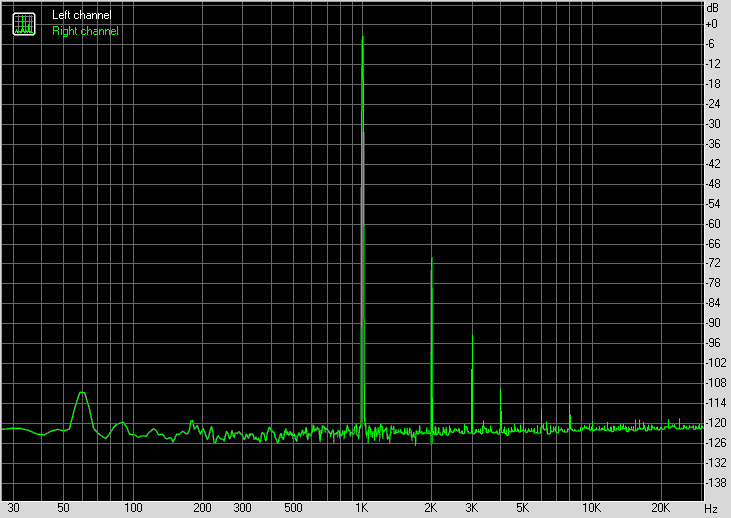
R6=50ohms:
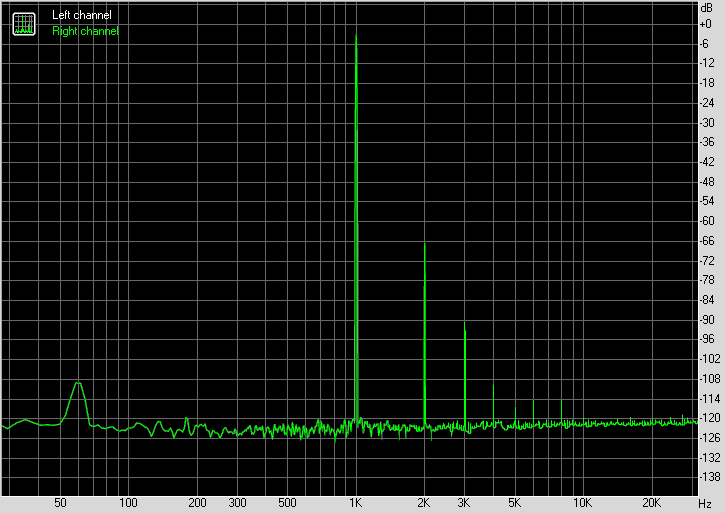
R6=75ohms:
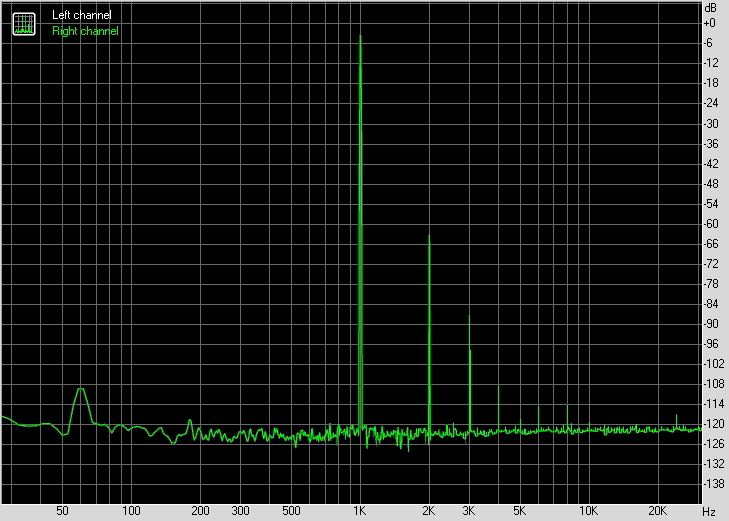
R6=100ohms:
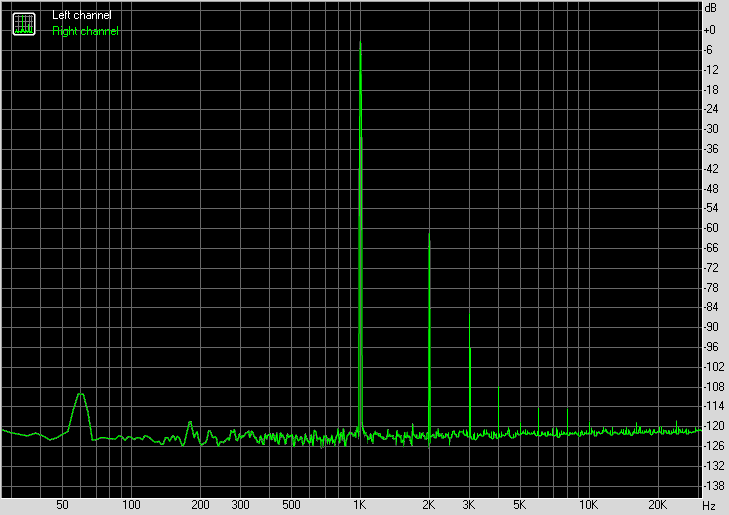
Here is a typical frequency response plot (multi-tone and not swept), you can see that this amp measures exceedingly well with a -0.5dB point of about 17Hz and upper limit is really just the sampling rate (set at 96kHz and 24bit):
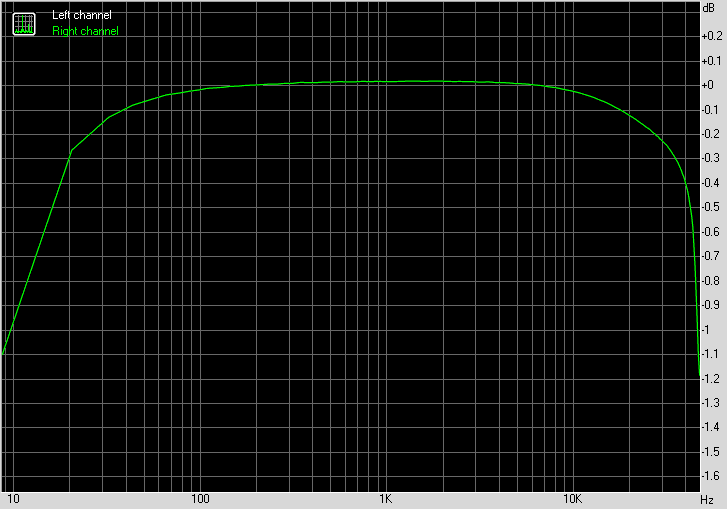
So we can see the trend of the H2 and H3 increasing with R6. The stated THD was as follows:
R6=0ohms, THD=0.033%
R6=25ohms, THD=0.046%
R6=50ohms, THD=0.068%
R6-75ohms, THD=0.101%
R6=100ohms, THD=0.123%
I also hooked up the left and right headphone channels to be driven from one amp in mono mode so I can hear a better representation of the full impact (without stereo or imaging). I hve listened extnsively to my collection of test tracks. I have to say this amp sounds very very good - nice deep bass that is articulate and powerful, very smooth mids, and an excellent presentation of treble detail without being harsh.
I even listened to it while adjusting the Niceness knob in real time. Most music (90%) I cannot detect an audible effect of the knob over the 0ohm to 100ohm range. However, on certain tracks in certain portions of the song, I can hear what I would describe as better detail and a more forward presentation when the Niceness knob is set at 0ohms and a more relaxed presentation (less analytical) when at 100ohms. It is most noticeable on the hard rock guitar intro by AC/DC for Highway to Hell. That track was recorded in a studio with extensive sound treatment as it is very dry and free of room ambiance. The strumming of the guitar can be described as a "duh duh duh" sound at R6=100ohms vs a "dah dah dah" sound at R6=0ohms. The detail is more crisp and vivid. So not necessarily better but very sublte and noticeable if one really concentrates. I am quite good at hearing distortion, but I think what we are hearing here may be how transient attacks are modified by the harmonic profile. The biggest thing we can hear are changes to the frequency response profile - but they are essentially identical.
Overall impression of this amp so far in mono is that it is excellent sounding and very low noise when operated by batteries. The detail and clarity of the BJT output is a bit different than a MOSFET. I can't pin it down but it sound different - not better or worse, just different.
You may ask me, what Niceness setting do I like to listen at? It's hard to say, but I think about the midpoint is a nice mix.
Aksa,
I know you have been waiting for this one... I hooked up the amp to the Focusrite Solo Gen2 audio interface and took some data. Initially with the SMPS and DC-DC converter. When using the DC-DC converter, too many HF artifacts showed up in the FFT so I removed it and connected a pair of fresh Li-ion 9v batteries (measure 16.0v) after the cap multiplier. The HF components were fairly low in the -100dB to -110dB range but I wanted to give this amp a fair test.

Here is a typical FFT with the DC-DC converter and 12v SMPS as power source:

So with batteries, I took data with R6 set from 0ohms to 100ohms in 25ohm steps. The trend is that at lower degeneration resistance values, the THD is lower, and increases pretty much linearly with increasing resistance. Note that there is a 60Hz peak but that is probably EMI pickup due to fact that amp is not in a metal box as everything is battery powered. The -120dB noise floor is quite flat otherwise.
R6=0ohms:

R6=25ohms:

R6=50ohms:

R6=75ohms:

R6=100ohms:

Here is a typical frequency response plot (multi-tone and not swept), you can see that this amp measures exceedingly well with a -0.5dB point of about 17Hz and upper limit is really just the sampling rate (set at 96kHz and 24bit):

So we can see the trend of the H2 and H3 increasing with R6. The stated THD was as follows:
R6=0ohms, THD=0.033%
R6=25ohms, THD=0.046%
R6=50ohms, THD=0.068%
R6-75ohms, THD=0.101%
R6=100ohms, THD=0.123%
I also hooked up the left and right headphone channels to be driven from one amp in mono mode so I can hear a better representation of the full impact (without stereo or imaging). I hve listened extnsively to my collection of test tracks. I have to say this amp sounds very very good - nice deep bass that is articulate and powerful, very smooth mids, and an excellent presentation of treble detail without being harsh.
I even listened to it while adjusting the Niceness knob in real time. Most music (90%) I cannot detect an audible effect of the knob over the 0ohm to 100ohm range. However, on certain tracks in certain portions of the song, I can hear what I would describe as better detail and a more forward presentation when the Niceness knob is set at 0ohms and a more relaxed presentation (less analytical) when at 100ohms. It is most noticeable on the hard rock guitar intro by AC/DC for Highway to Hell. That track was recorded in a studio with extensive sound treatment as it is very dry and free of room ambiance. The strumming of the guitar can be described as a "duh duh duh" sound at R6=100ohms vs a "dah dah dah" sound at R6=0ohms. The detail is more crisp and vivid. So not necessarily better but very sublte and noticeable if one really concentrates. I am quite good at hearing distortion, but I think what we are hearing here may be how transient attacks are modified by the harmonic profile. The biggest thing we can hear are changes to the frequency response profile - but they are essentially identical.
Overall impression of this amp so far in mono is that it is excellent sounding and very low noise when operated by batteries. The detail and clarity of the BJT output is a bit different than a MOSFET. I can't pin it down but it sound different - not better or worse, just different.
You may ask me, what Niceness setting do I like to listen at? It's hard to say, but I think about the midpoint is a nice mix.
Attachments
-
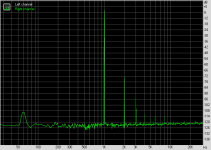 JFET-BJT-Amp-HD-R6-0ohms-Li-batt.png6.9 KB · Views: 757
JFET-BJT-Amp-HD-R6-0ohms-Li-batt.png6.9 KB · Views: 757 -
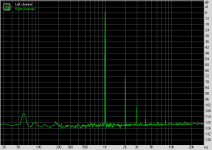 JFET-BJT-Amp-HD-R6-25ohms-Li-batt.png6.9 KB · Views: 742
JFET-BJT-Amp-HD-R6-25ohms-Li-batt.png6.9 KB · Views: 742 -
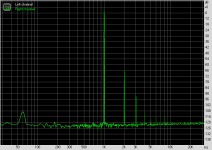 JFET-BJT-Amp-HD-R6-50ohms-Li-batt.png6.8 KB · Views: 742
JFET-BJT-Amp-HD-R6-50ohms-Li-batt.png6.8 KB · Views: 742 -
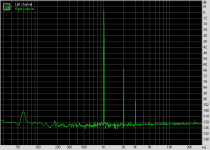 JFET-BJT-Amp-HD-R6-75ohms-Li-batt.png7 KB · Views: 744
JFET-BJT-Amp-HD-R6-75ohms-Li-batt.png7 KB · Views: 744 -
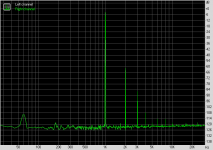 JFET-BJT-Amp-HD-R6-100ohms-Li-batt.png6.8 KB · Views: 753
JFET-BJT-Amp-HD-R6-100ohms-Li-batt.png6.8 KB · Views: 753 -
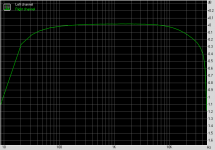 JFET-BJT-Amp-FR-Multitone-R6-50ohms-Li-batt.png5.2 KB · Views: 728
JFET-BJT-Amp-FR-Multitone-R6-50ohms-Li-batt.png5.2 KB · Views: 728 -
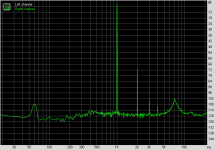 JFET-BJT-Amp-HD-R6-50ohms.png7.1 KB · Views: 792
JFET-BJT-Amp-HD-R6-50ohms.png7.1 KB · Views: 792 -
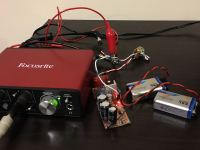 JFET-BJT-Amp-Li-Batt-Test-Photo.png862.2 KB · Views: 802
JFET-BJT-Amp-Li-Batt-Test-Photo.png862.2 KB · Views: 802
Last edited:
FFT with 10w trafo and CRC
I was curious what the noise performance would look like with a traditional mains connected trafo and CRC prior to the cap Mx. I am using an Antek 0115 10w 15vac toroidal trafo with 20mF//0.33R//20mF CRC. The voltage after the cap Mx is 16.4vdc. There appears to be about a +6dB increase in the 60Hz peak which is now at -102dB - still very reasonable and inaudible as far as I can tell. This is at the midpoint 50ohms Niceness setting.
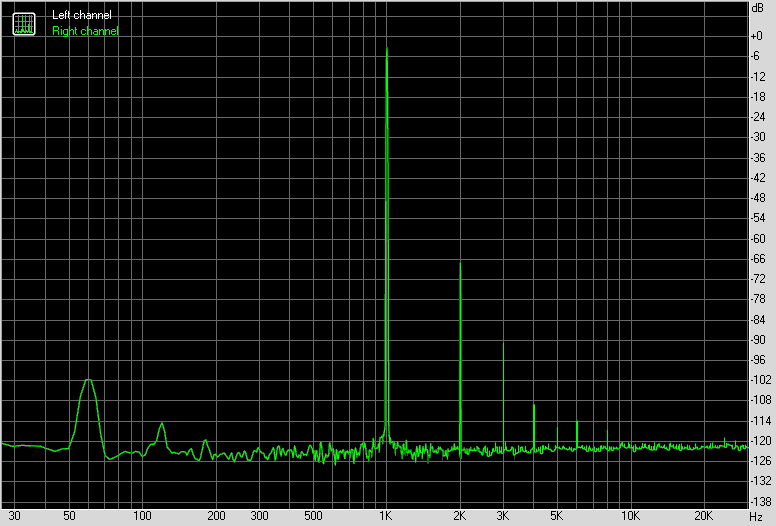
This could easily be the basis of a nice desktop amp when using the trafo.
I was curious what the noise performance would look like with a traditional mains connected trafo and CRC prior to the cap Mx. I am using an Antek 0115 10w 15vac toroidal trafo with 20mF//0.33R//20mF CRC. The voltage after the cap Mx is 16.4vdc. There appears to be about a +6dB increase in the 60Hz peak which is now at -102dB - still very reasonable and inaudible as far as I can tell. This is at the midpoint 50ohms Niceness setting.

This could easily be the basis of a nice desktop amp when using the trafo.
Attachments
Thank you XRK,
A seminal investigation. You have incisively correlated the measured data with my quick analysis using LTSpice.
A do feel a linear, monotonic profile sounds best and Jean Hiraga noticed this in La Revue du Son in thelate sixties.
Some headphones can fatigue; maybe 50r of master source degen ameliorates the effect?
You mentioned using 2SA1381 and the big daddy, the 2SA1837. I believe both would enhance the resolution and given your listening tests you might not like the effect, and of course they cost more and offer better beta, gm and Vceo you do not need!
Great work X thanks again!
HD
A seminal investigation. You have incisively correlated the measured data with my quick analysis using LTSpice.
A do feel a linear, monotonic profile sounds best and Jean Hiraga noticed this in La Revue du Son in thelate sixties.
Some headphones can fatigue; maybe 50r of master source degen ameliorates the effect?
You mentioned using 2SA1381 and the big daddy, the 2SA1837. I believe both would enhance the resolution and given your listening tests you might not like the effect, and of course they cost more and offer better beta, gm and Vceo you do not need!
Great work X thanks again!
HD
Hi Hugh,
I will install an 2SA1837 when I get back tonight. I like the higher beta - I need more gain out of this when driven by a phone. Maybe the extra resolution will be dazzling and not fatiguing? So easy to try...
I would like to use this as a basis for desktop headamp, so want to crank the bias up and give a nice heatsink. Maybe 125mA? I will play around in LTSpice to see how to make that happen but assume it has to do with voltage divider (R3/R4) that sets the bias on JFET and perhaps reducing the values of the power resistors (R8/R9)?
I will install an 2SA1837 when I get back tonight. I like the higher beta - I need more gain out of this when driven by a phone. Maybe the extra resolution will be dazzling and not fatiguing? So easy to try...
I would like to use this as a basis for desktop headamp, so want to crank the bias up and give a nice heatsink. Maybe 125mA? I will play around in LTSpice to see how to make that happen but assume it has to do with voltage divider (R3/R4) that sets the bias on JFET and perhaps reducing the values of the power resistors (R8/R9)?
JFET-BJT Headamp in Stereo
I built up the second channel and it fired right up no issues. Measurements of HD spectra at 0 ohms, 50ohms, and 100 ohms look consistent between left (new one) and right channels and behave similarly to earlier measurements. Now I can listen in true stereo and the sound is very nice. Will give detailed impressions later - it's real late now and need to get some rest...
Setup with trafo and CRC PSU. I am sharing the PSU for this initial test but will make dedicated second CRC for a true monoblock in the future:
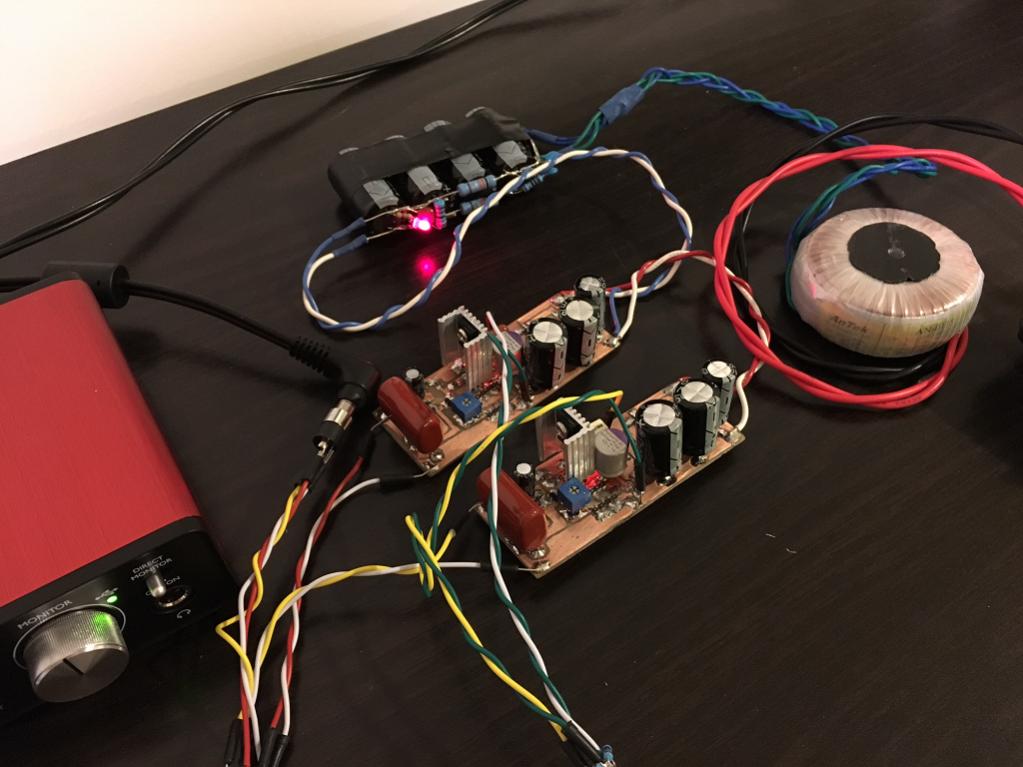
Closeup of the two boards:
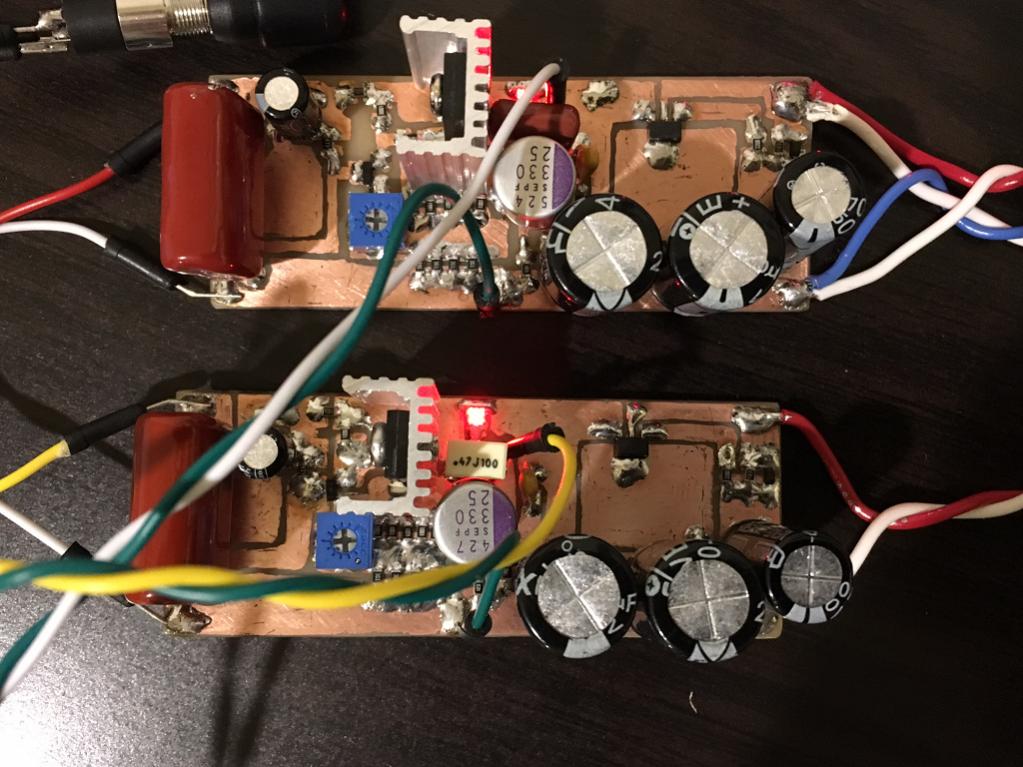
FFT at 1kHz and 700mV output into 270ohms (96kHz 24bit DAQ) w/ R6=0 ohms:
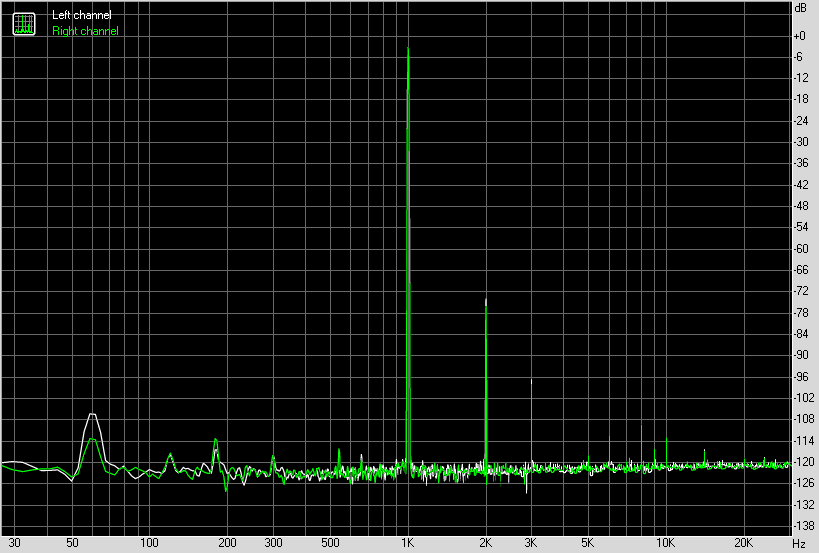
FFT at R6 = 50ohms:
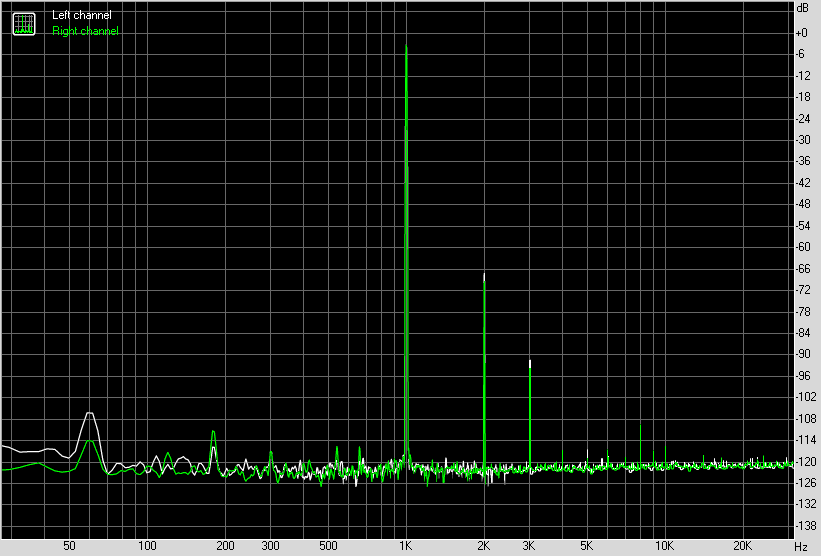
FFT at R6 = 100ohms:
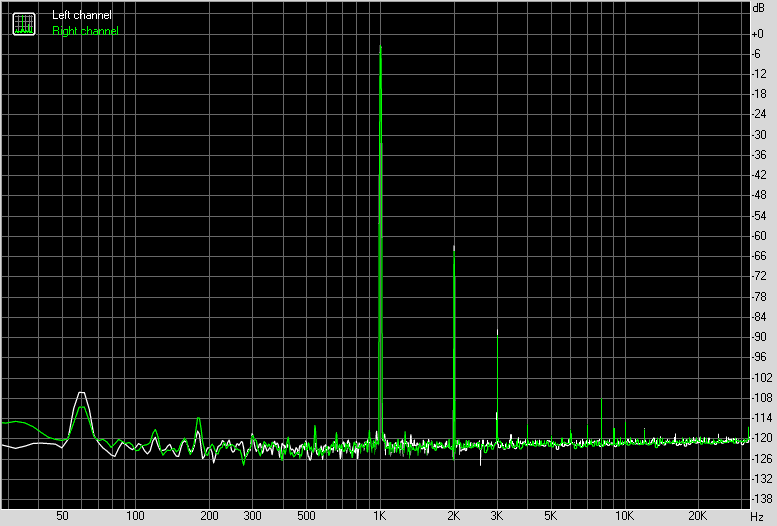
Frequency Response (multi-tone) at R6 = 50ohms:
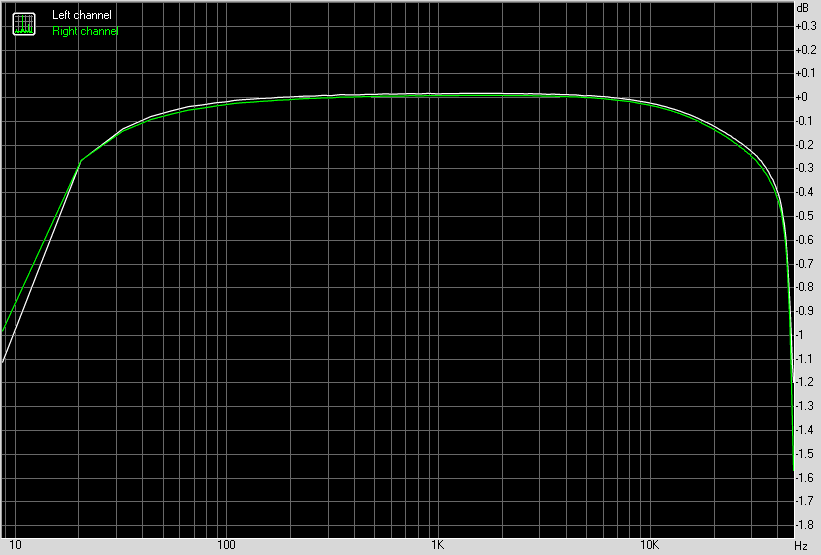
Measured THD was 0.027% at R6=0ohms, 0.057% at R6=50ohms, and 0.099% at R6=100ohms.
I built up the second channel and it fired right up no issues. Measurements of HD spectra at 0 ohms, 50ohms, and 100 ohms look consistent between left (new one) and right channels and behave similarly to earlier measurements. Now I can listen in true stereo and the sound is very nice. Will give detailed impressions later - it's real late now and need to get some rest...
Setup with trafo and CRC PSU. I am sharing the PSU for this initial test but will make dedicated second CRC for a true monoblock in the future:

Closeup of the two boards:

FFT at 1kHz and 700mV output into 270ohms (96kHz 24bit DAQ) w/ R6=0 ohms:

FFT at R6 = 50ohms:

FFT at R6 = 100ohms:

Frequency Response (multi-tone) at R6 = 50ohms:

Measured THD was 0.027% at R6=0ohms, 0.057% at R6=50ohms, and 0.099% at R6=100ohms.
Attachments
-
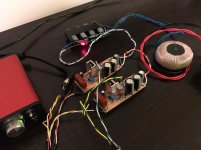 JFET-BJT-AMp-Stereo-Photo-01.jpg79.5 KB · Views: 1,296
JFET-BJT-AMp-Stereo-Photo-01.jpg79.5 KB · Views: 1,296 -
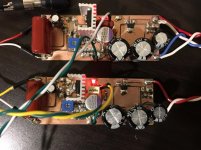 JFET-BJT-AMp-Stereo-Photo-02.jpg113.4 KB · Views: 3,340
JFET-BJT-AMp-Stereo-Photo-02.jpg113.4 KB · Views: 3,340 -
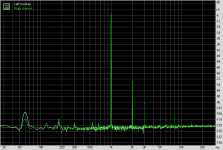 JFET-BJT-Amp-HD-R6-0ohms-trafo-Stereo.png10.1 KB · Views: 663
JFET-BJT-Amp-HD-R6-0ohms-trafo-Stereo.png10.1 KB · Views: 663 -
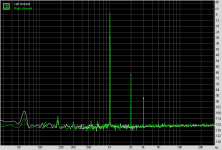 JFET-BJT-Amp-HD-R6-50ohms-trafo-Stereo.png10.4 KB · Views: 951
JFET-BJT-Amp-HD-R6-50ohms-trafo-Stereo.png10.4 KB · Views: 951 -
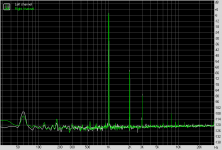 JFET-BJT-Amp-HD-R6-100ohms-trafo-Stereo.png9.4 KB · Views: 657
JFET-BJT-Amp-HD-R6-100ohms-trafo-Stereo.png9.4 KB · Views: 657 -
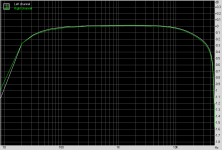 JFET-BJT-Amp-FR-R6-50ohms-trafo-Stereo.png7.7 KB · Views: 944
JFET-BJT-Amp-FR-R6-50ohms-trafo-Stereo.png7.7 KB · Views: 944
Last edited:
Listening impressions and sound clips
This is a very nice sounding amp. Just super clear and musical with nice dynamics, deep reaching bass that is punchy and super fluid mids and a high end that doesn't leave me wondering if something got left out. Never boring or sterile sounding but not inaccurate either.
I listened to my usual test tracks and they all sound great on my DT880-250 headphones. There is no lack of bass with this amp - which is substantiated with the -0.5dB at 17Hz frequency response measurement.
Attached are mp3 sound clips recorded from the amp driving 270ohm metal thin film resistor loads, and digitized with a Focusrite Solo 2nd gen at 48kHz and then converted to 320kbit mp3 using Audacity. Change the filename extension from .asc to .mp3 to listen.
Let me know what you think. Oh, this is at the middle Niceness setting of 50ohms on R6.

This is a very nice sounding amp. Just super clear and musical with nice dynamics, deep reaching bass that is punchy and super fluid mids and a high end that doesn't leave me wondering if something got left out. Never boring or sterile sounding but not inaccurate either.
I listened to my usual test tracks and they all sound great on my DT880-250 headphones. There is no lack of bass with this amp - which is substantiated with the -0.5dB at 17Hz frequency response measurement.
Attached are mp3 sound clips recorded from the amp driving 270ohm metal thin film resistor loads, and digitized with a Focusrite Solo 2nd gen at 48kHz and then converted to 320kbit mp3 using Audacity. Change the filename extension from .asc to .mp3 to listen.
Let me know what you think. Oh, this is at the middle Niceness setting of 50ohms on R6.

Attachments
Last edited:
Feedback anyone on the sound of this amp from listening to the sound clips? I have done a lot more listening and continue to like this amp more and more. I think I am going to work on a desktop version with 2SA1837's for outputs and running maybe 110mA bias. Should have H2 at -80dB and H3 about 30x less with nothing else.
BF862-2SA1837 Headamp
Aksa helped me to adjust the circuit for a desktop high-bias version of the JFET-BJT using the venerable Toshiba 2SA1837 BJT driver. The bias current is set at 135mA with a 20.0v power supply provided by a 24v SMPS and a Juma cap Mx (IRFP240 based), followed by a low ESR 24mF cap array.
Here is the PCB layout as drawn using a Sharpie marker just before the acid etch:
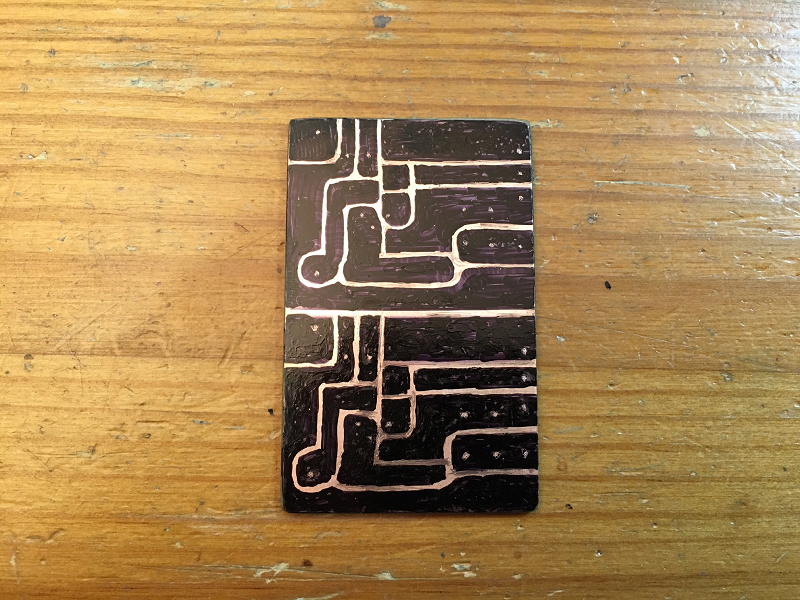
Here is a closeup of the amp as built using SMT components where possible. I have 2.2uF 250v MKT input coupling caps, 390uF 20v Panasonic OSCON output coupling caps with 0.47uF 100v MKP bypass caps. The Niceness trimmer is set at 68R:
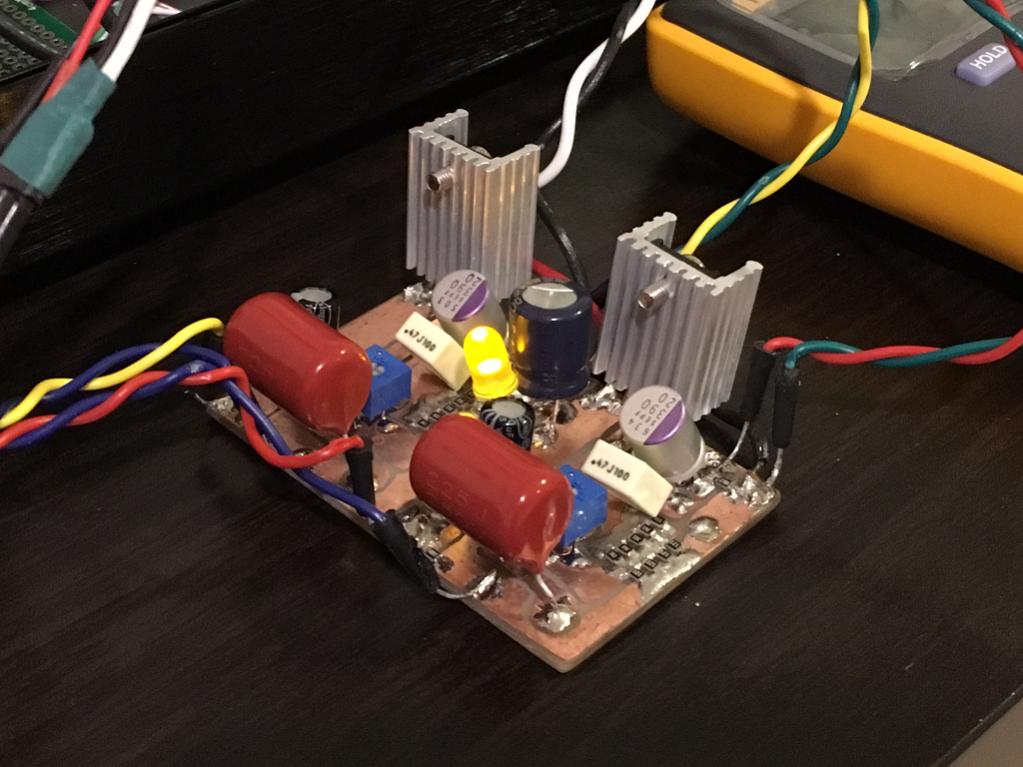
Here is the setup with the power supply consisting of 5amp 24v SMPS, cap Mx, and cap array:
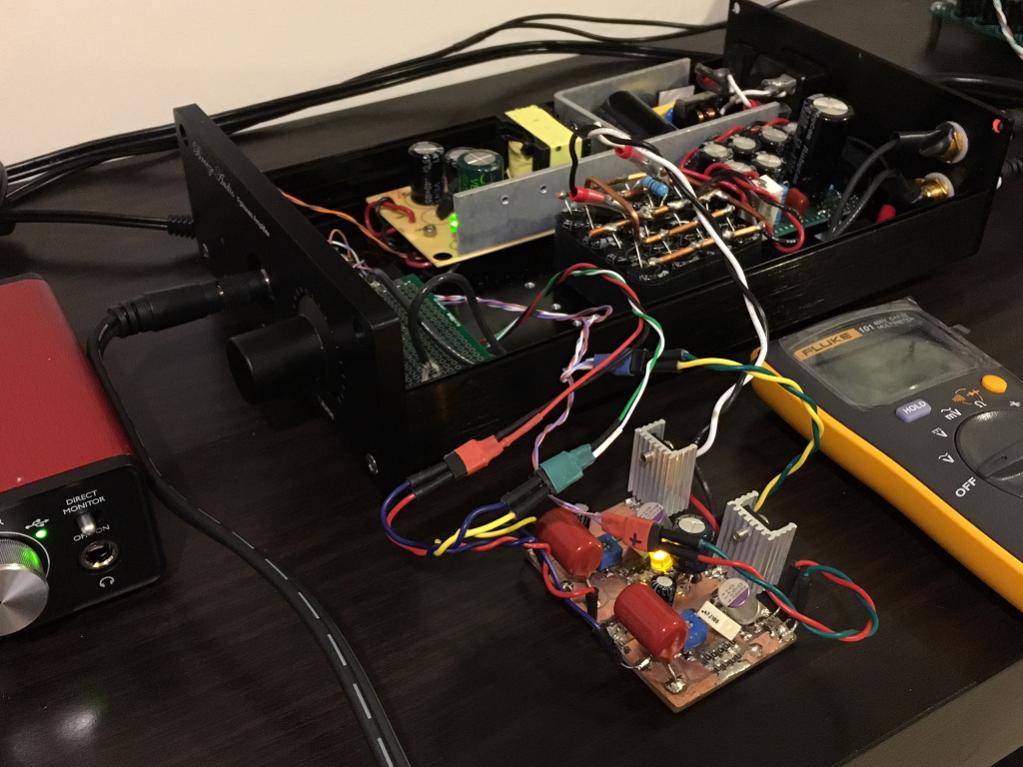
With the above setup, I measured the following harmonic distortion profile for 1kHz excitation and 700mV output into 270R load. The stated THD was 0.0037% - a very nice low figure resulting from a superior output stage BJT and a nice hot running bias current. Some switch mode noise is still managing to leak through but it's down pretty low at -90dB to -100dB. However, the measured H2 component is -90dB (lower than predicted!) and the H3 is -12dB less than H2 and the rest is down in the weeds. This is an excellent result for such a simple amp and the profile is very nice:
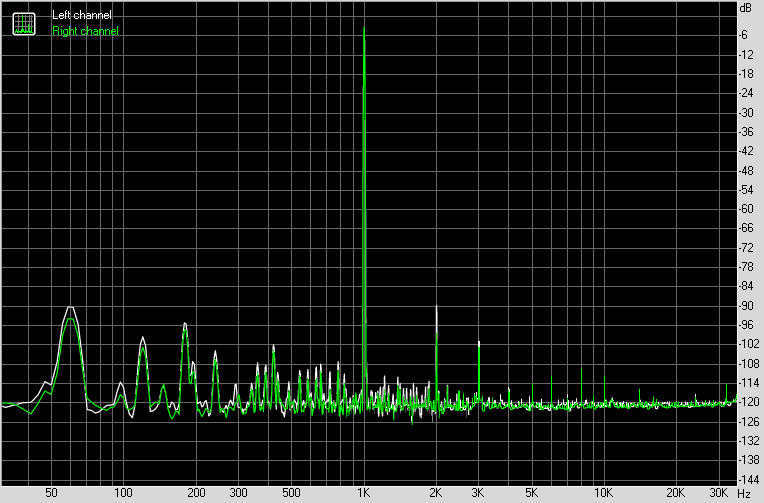
Here is the measured (multi-tone) frequency response:
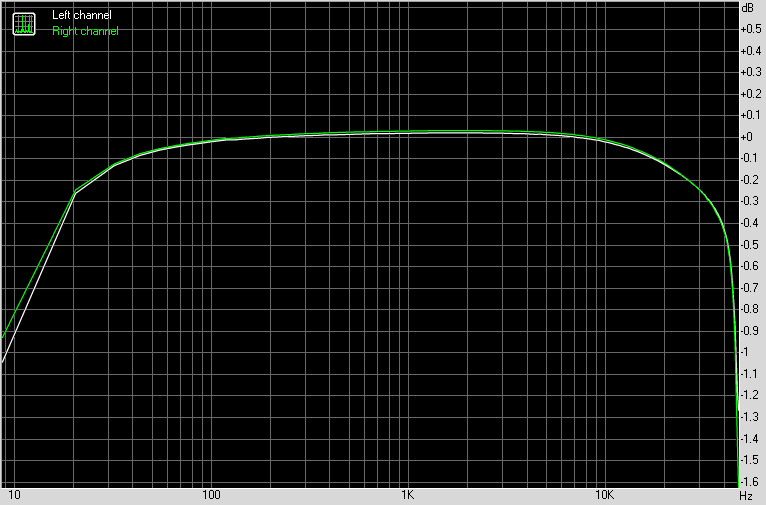
Listening to is so far with a couple of tracks has not disappointed me. Superb bass authority, very transparent and clear, great smoothness, nice highs. Super quiet when no music playing or during quiet passages. Those SMT resistors are probably not the best choice for this as they are running way over their rating at present (1.3w vs rated 625mW). As you can imagine, the PCB is hot to the touch from all that heat. I will thermally bond it to the aluminum case with some white RTV.
Aksa helped me to adjust the circuit for a desktop high-bias version of the JFET-BJT using the venerable Toshiba 2SA1837 BJT driver. The bias current is set at 135mA with a 20.0v power supply provided by a 24v SMPS and a Juma cap Mx (IRFP240 based), followed by a low ESR 24mF cap array.
Here is the PCB layout as drawn using a Sharpie marker just before the acid etch:

Here is a closeup of the amp as built using SMT components where possible. I have 2.2uF 250v MKT input coupling caps, 390uF 20v Panasonic OSCON output coupling caps with 0.47uF 100v MKP bypass caps. The Niceness trimmer is set at 68R:

Here is the setup with the power supply consisting of 5amp 24v SMPS, cap Mx, and cap array:

With the above setup, I measured the following harmonic distortion profile for 1kHz excitation and 700mV output into 270R load. The stated THD was 0.0037% - a very nice low figure resulting from a superior output stage BJT and a nice hot running bias current. Some switch mode noise is still managing to leak through but it's down pretty low at -90dB to -100dB. However, the measured H2 component is -90dB (lower than predicted!) and the H3 is -12dB less than H2 and the rest is down in the weeds. This is an excellent result for such a simple amp and the profile is very nice:

Here is the measured (multi-tone) frequency response:

Listening to is so far with a couple of tracks has not disappointed me. Superb bass authority, very transparent and clear, great smoothness, nice highs. Super quiet when no music playing or during quiet passages. Those SMT resistors are probably not the best choice for this as they are running way over their rating at present (1.3w vs rated 625mW). As you can imagine, the PCB is hot to the touch from all that heat. I will thermally bond it to the aluminum case with some white RTV.
Attachments
Last edited:
Feedback anyone on the sound of this amp from listening to the sound clips?
Instead of uploading all these worthless, short sound clips that would sound okay even on a 1970's AM radio, why don't you upload a complete song with vocals from someone like the Eagles, Natalie Merchant or anyone that a lot of people are familiar with?
All this jazz and instrumental garbage sounds great on almost any amplifier, no matter how bad the design is.
Closed Box FFT
I closed up the cover to the case and the FFT looks a lot cleaner now. Much of the noise below 1kHz went away. However, the H2 and H3 peaks seem to have gone up by 6dB to -84dB and -96dB for H3. Still a very good result.
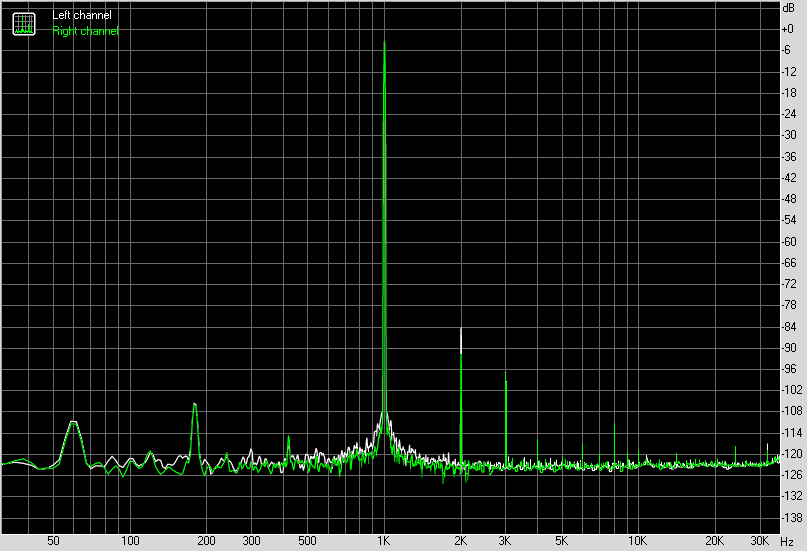
I closed up the cover to the case and the FFT looks a lot cleaner now. Much of the noise below 1kHz went away. However, the H2 and H3 peaks seem to have gone up by 6dB to -84dB and -96dB for H3. Still a very good result.

Attachments
Instead of uploading all these worthless, short sound clips that would sound okay even on a 1970's AM radio, why don't you upload a complete song with vocals from someone like the Eagles, Natalie Merchant or anyone that a lot of people are familiar with?
All this jazz and instrumental garbage sounds great on almost any amplifier, no matter how bad the design is.
Sorry you are unfamiliar with a lot of well-recorded music. If you think it's worthless then don't listen to it. In order to record songs at 320kbit, a maximum of 45 seconds is the limit of the DIYA servers (1.8MB). The September in Montreal clip by Anne Bisson is perhaps one of the finest examples of audio mastering and recording available for hifi systems. Keith Don't Go by Nils Lofgren is another example of a superb recording of instrumental guitar. I would argue that highly produced pop like Natalie Merchant would sound good on any amplifier/speaker. There is a good Eagles rendition of Hotel California.
I have a bunch of threads comparing speakers with this method and I do provide the source tracks so you can compare.
Examples here from Round 3 (I have done like 6 different rounds):
http://www.diyaudio.com/forums/full...ind-comparison-2in-4in-drivers-round-3-a.html
Here are some clips recorded from the new BF862-2SA1837 headamp with source reference tracks for you to compare.
Attachments
Last edited:
Instead of uploading all these worthless, short sound clips that would sound okay even on a 1970's AM radio, why don't you upload a complete song with vocals from someone like the Eagles, Natalie Merchant or anyone that a lot of people are familiar with?
All this jazz and instrumental garbage sounds great on almost any amplifier, no matter how bad the design is.
Dude, rather than demanding your requirements, and given that specs ARE important and clearly give a lot of information about how the amp is working, good and bad why don't you trying being positive, and thank X for important, interesting data that many people find useful and drop the negative vibes?
HD
really great sound X and HD , with a DA and AD between....
Thanks for the feedback. It's quite impressive given that the source material is MP3 (not flac) playing through a DAC and then amplified by the DUT then recorded with ADC and presented back to the listener as MP3. This is using a fairly inexpensive audio interface (Focusrite Solo 2G) at 48kHz and 24bits.
Had the source started as lossless FLAC and everything played and recorded at 192kHz and 24bit in FLAC, it would probably sound even better.
- Home
- Amplifiers
- Headphone Systems
- MOSFET Source Follower Headamp
